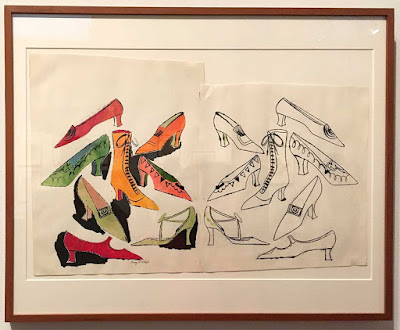About a week ago, I posted a self-portrait of a young artist and asked readers to guess who it was. No one got it, and I can see why. I wouldn't recognize him either.
The answer is Andy Warhol, and the city in question is Pittsburgh, which I visited recently. The Warhol museum is the largest museum in the U.S. devoted to a single artist. The part of it I enjoyed the most was the highest floor, devoted to his early years.
There were several of his art school explorations:

(The teacher noted "good drawing" on the lower right corner.)

There were several of these street scenes, drawn from life.
Warhol's earliest painting is included. It's titled "Nose Picker 1: Why Pick on Me," though it was originally titled "The Lord Gave Me My Face but I Can Pick My Own Nose," 1948 (age 20).

Another painting, titled "Three Children," hangs beside it:

Warhol left Pittsburgh for New York just after art school in the early 1950s and almost immediately became a successful advertising illustrator. According to the accompanying text,
Warhol’s professional success as a commercial illustrator was largely due to his ability to create art very quickly and his willingness to respond to the revisions clients demanded. One of the most well-known 1950s ad campaigns he helped create was for I. Miller Shoes. The idea of decorative beauty was exaggerated in almost all of these illustrations, and at times the image of the shoe became very abstract….


The panel continues:
Among the art directors with whom he worked, Warhol was known for his timid yet appealing personality. He was a quick study — given an assignment, he would turn in a brown paper bag full of drawings on the subject the very next day. His simple yet sophisticated drawing style, in contrast to the era’s burgeoning use of photographic advertising, appealed to art directors, as well as to the post-war Americans, who were becoming savvy consumers.By the late 1950s, Warhol was employing assistants and making $70,000 a year, which is about $600,000 in 2016 dollars. (I wonder if he knew Ellen Raskin, who was also a successful New York illustrator at the time?)
I loved this drawing for "The Magic Flute":

The museum does a great job of explaining Warhol's blotted-line inking technique, including a video. Their text gives these details:
In the 1950s Warhol refined a process that he had discovered in college, creating a signature style for his illustrations with a technique known as “blotted line.” This working method combined drawing with basic print-making and allowed Warhol to repeat an image and to create multiple illustrations along a similar theme….Warhol used this technique in some of his earlier noncommercial works as well, such as this three-panel screen:
Warhol’s blotted line process had several complex steps. First, he drew or traced a line drawing onto a piece of non-absorbent paper, such as tracing paper. Next, he hinged the tracing paper to a second sheet of absorbent paper by taping the edges together on one side. Opening the papers like a book and using a nib pen, Warhol inked over a small section of the lines on the tracing paper. He then transferred the wet ink onto the absorbent sheet by closing the pages and lightly pressing or “blotting.” He repeated this inking and blotting until the whole drawing was transferred.
Completing a large blotted line drawing took time and multiple pressings. The method resulted in dotted, broken, and delicate lines. Warhol colored his blotted line drawings with water soluble dyes and applied gold leave. He also used hand-carved rubber stamps to create patterns, often combining both techniques in a drawing.

One detail about his work that I found especially interesting was the lettering that appears in some of his earlier works. Here's the story on that:
[Warhol's mother] Julia was a highly original, though untrained, artist in her own right. Her subjects were often cats and angels… During Warhol’s early commercial years, Julia was his first assistant and collaborator. Warhol incorporated her beautiful handwriting into his design work and she began signing her son’s name to his work. Warhol also turned her handwriting into several custom-made Letraset [sheets].

From there the displays segue into the soup cans and Brillo boxes we all associate with Warhol, and there's lots of cool details to see and minor facts to learn. But it's too much for a blog post, so I'll stop there.
Oh, wait, there was one artifact on a lower floor that I just have to include. It's the original photo, with Warhol's crop marks indicated, that he used for his many famous silk screen prints of Marilyn Monroe:

If you get to Pittsburgh, be sure to visit Marilyn and Andy.


No comments:
Post a Comment